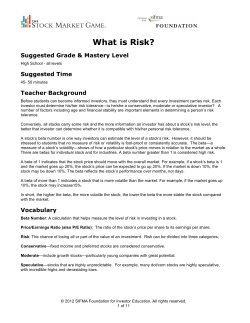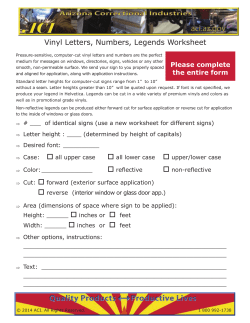
WHAT IS THE TOLERANCE? THE MCINTOSH GROUP 1850 South Boulder Avenue
WHAT IS THE TOLERANCE? By M. Bradley Gaskins, AIA and Ellis L. McIntosh Jr., AIA THE MCINTOSH GROUP 1850 South Boulder Avenue Tulsa, OK 74119 918.585.8555 • tmgada.com © 2011 The McIntosh Group, LLC WHAT IS THE TOLERANCE? Both the 1991 and 2010 ADA Standards allow for construction tolerances in construction and the determination of compliance with the Standards. The key term that is used in both is "conventional industry tolerances." The Standards, however, leave the question "What is the conventional industry tolerance?" unanswered and are silent on an authoritative source for such tolerances: 3.2 Dimensional Tolerances. All dimensions are subject to conventional building industry tolerances for field conditions. 104.1.1 Construction 1 and Manufacturing Tolerances. All dimensions are 2subject to conventional industry tolerances except where3 the requirement is stated as a range with MUST COMPLY WITH 1991 STANDARD MUST COMPLY WITH 2010 STANDARD specific minimum and maximum end points. TRANSITION PERIOD The issue with this silence is that there is not a single independent source for such tolerances that is recognized and accepted. This article is intended to delve into the issue of surface tolerances, specifically related to paved surfaces, and set forth a rationale and proposal for tolerances that we believe to be achievable, defendable and easily measured. As a result, it could and should be recognized as “conventional building industry tolerances for field conditions”. THE ISSUE Surfaces related to accessible routes are required to conform to precise requirements defined in the Standards related to their characteristic (running, cross, ramp), of which we are all familiar. Current industry practices related to forming, placing and finishing concrete and other plastic materials, however, make it difficult and are highly unlikely to yield results consistent with these standards. The concrete industry itself has published “conventional building industry tolerances” that, if achieved, WILL NOT comply with the standards. For instance, the American Concrete Institute ACI 117 sets forth that, using a 10-foot straightedge, a gap between the straight-edge and the surface cannot exceed 1/4”. It DOES NOT limit the number of such gaps. The conclusion of this paragraph is that the conventional building industry tolerance may yield a surface that does not comply with the standard. P. 01 © 2011 The McIntosh Group, LLC WHAT IS THE TOLERANCE? THE UNSPOKEN ISSUE The conventional tool for verifying compliance with slope requirements is the M-D 24” SmartTool digital level. According to the manufacturer’s standards1 this unit is accurate to 0.1° at 0° and 90°. At all other angles it is accurate to 0.2°. Attention must be paid to the fact that these are DEGREES and not PERCENT, as specified in the Standards. When this is translated to percent, you get 0.35% (or 0.4% when rounded to the display of the tool which reads in 1/10th of a percent increments). Thus, any field reading of the instrument could be off by 0.4% in either direction, not including “conventional building industry tolerances”. Considering Ballast calls for construction that should be built to a 0.5% tolerance measured with the SmartTool, it is easily recognized that the surface construction must actually be within a 1/32” tolerance across the length of the level. Is that a reasonable expectation? The conclusion is that before considering conventional building industry tolerance, the tool itself could yield a reading that would erroneously fail the surface. CONVENTIONAL BUILDING INDUSTRY TOLERANCE To consider a tolerance that is reasonable to achieve over the length of the level the industry standard for flatness must be considered. ACI 117 is the conventional building industry tolerance in this case. Understanding this in context with the M-D 24” digital level (ignoring for a moment the tool accuracy) it would be reasonable to expect that at any single point, the actual measurement taken could easily be off by 1/4 inch per foot, or 2.1%, and compliant with the ACI 117 allowable tolerance. Our 2.1% conclusion, coupled with the tool accuracy could therefore establish a maximum allowable tolerance of 2.5% (0.4% + 2.1%). Thus, an allowable cross slope would be 4.5% (2.0% + 2.5%), running slope 7.5% (5.0% + 2.5%), and ramp slope 10.8% (8.3% + 2.5%). Do these final measurements with tolerances seem reasonable? We would not necessarily think so as an overall but could conclude that any one reading within these parameters should not be a reason to fail a surface for being out of compliance. Repetitive readings at these maximum numbers would cause us to take a second look at the surface and its compliance. P. 02 © 2011 The McIntosh Group, LLC WHAT IS THE TOLERANCE? RECOMMENDED MEASUREMENT TOLERANCE Based upon simplicity, accuracy and easy transportability the 24” digital level will most likely continue to be the tool of choice. Based upon the analysis above, as long as no single reading exceeds 2.5% above the minimum requirement, the surface should not fail. The question then becomes what measurement is reasonable to expect from the actual construction. The answer to this must be based upon what is actually being measured with the tool. It is simply a 2 foot long section of surface. This can be considered in 2 ways. First for measuring device accuracy, the instrument and technique for measurement should provide for an accuracy of at least 1/3 the required tolerance. With our known accuracy of the level of 0.4% this would allow for a minimum required tolerance of 1.2%. Second, based upon the ACI standard allowable 1/4” gap, the tolerance would become 1/4 inch over 2 feet or 1/8 inch per foot. This establishes an actual construction tolerance of 1.0%. Combine this with the tool accuracy and you get an allowable tolerance of 1.4% (0.4% + 1.0%). Based upon this logic, our recommend actual allowable measurements are as follows: NOTE: The exact language and requirements can be found in the 1991 and 2010 Standards. 1. http://smarttoollevels.com/index.php/specifications. M-D Building Products. n.d. 21 April 2011. P. 03 © 2011 The McIntosh Group, LLC
© Copyright 2025


















